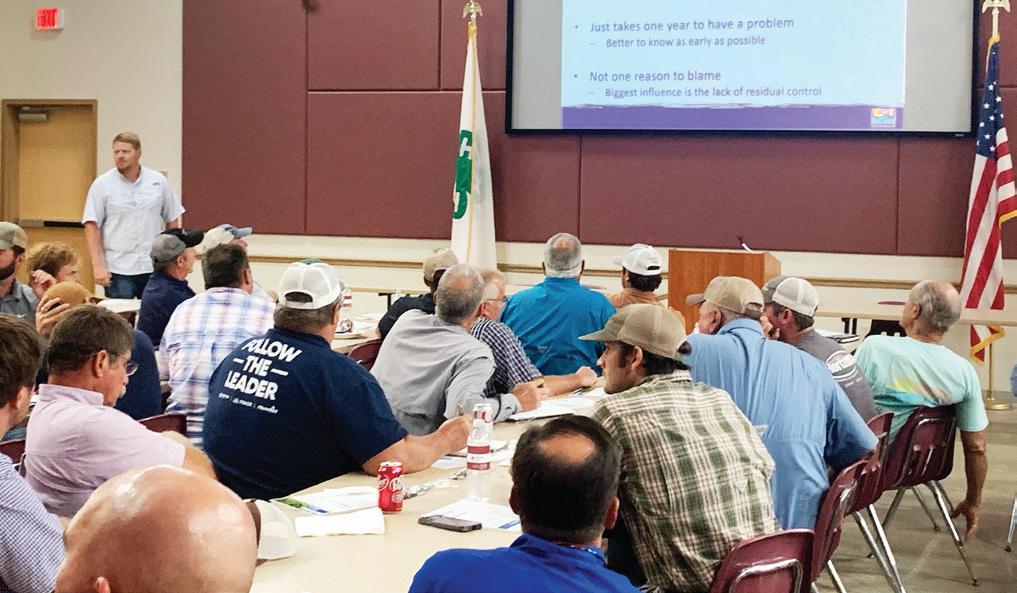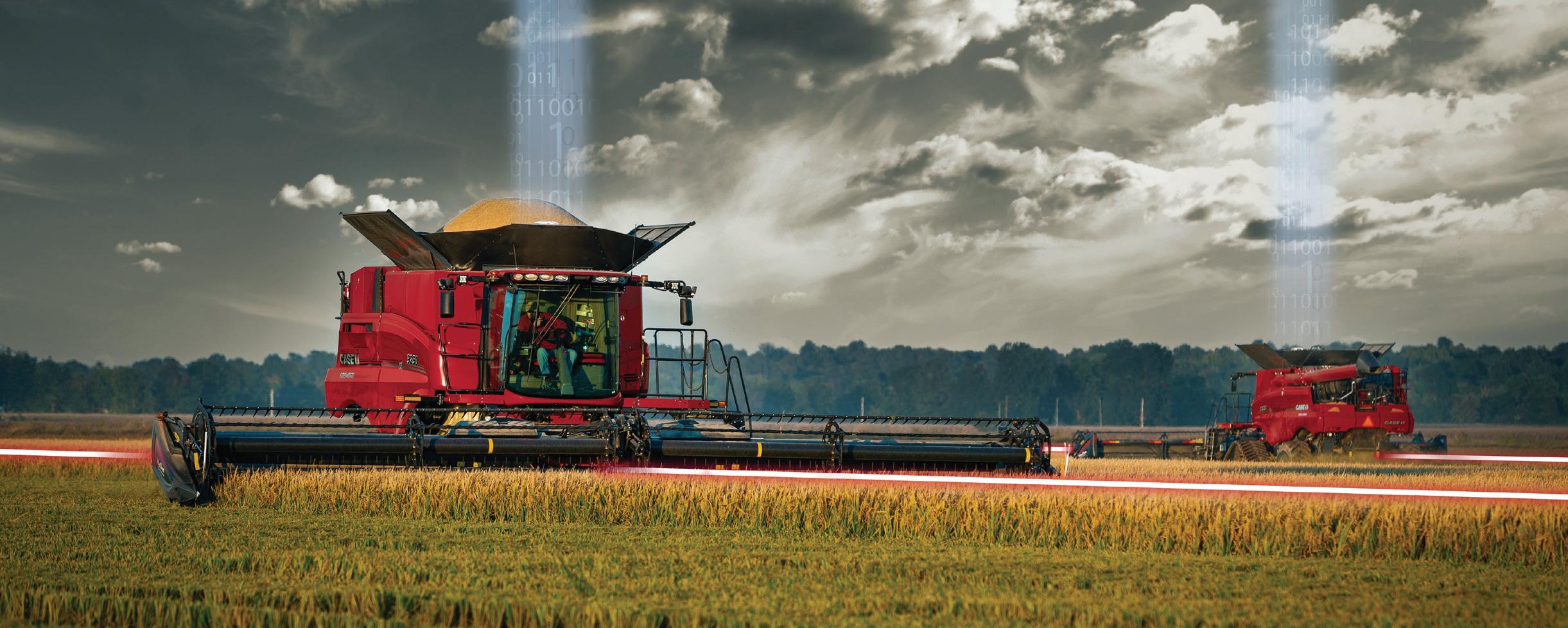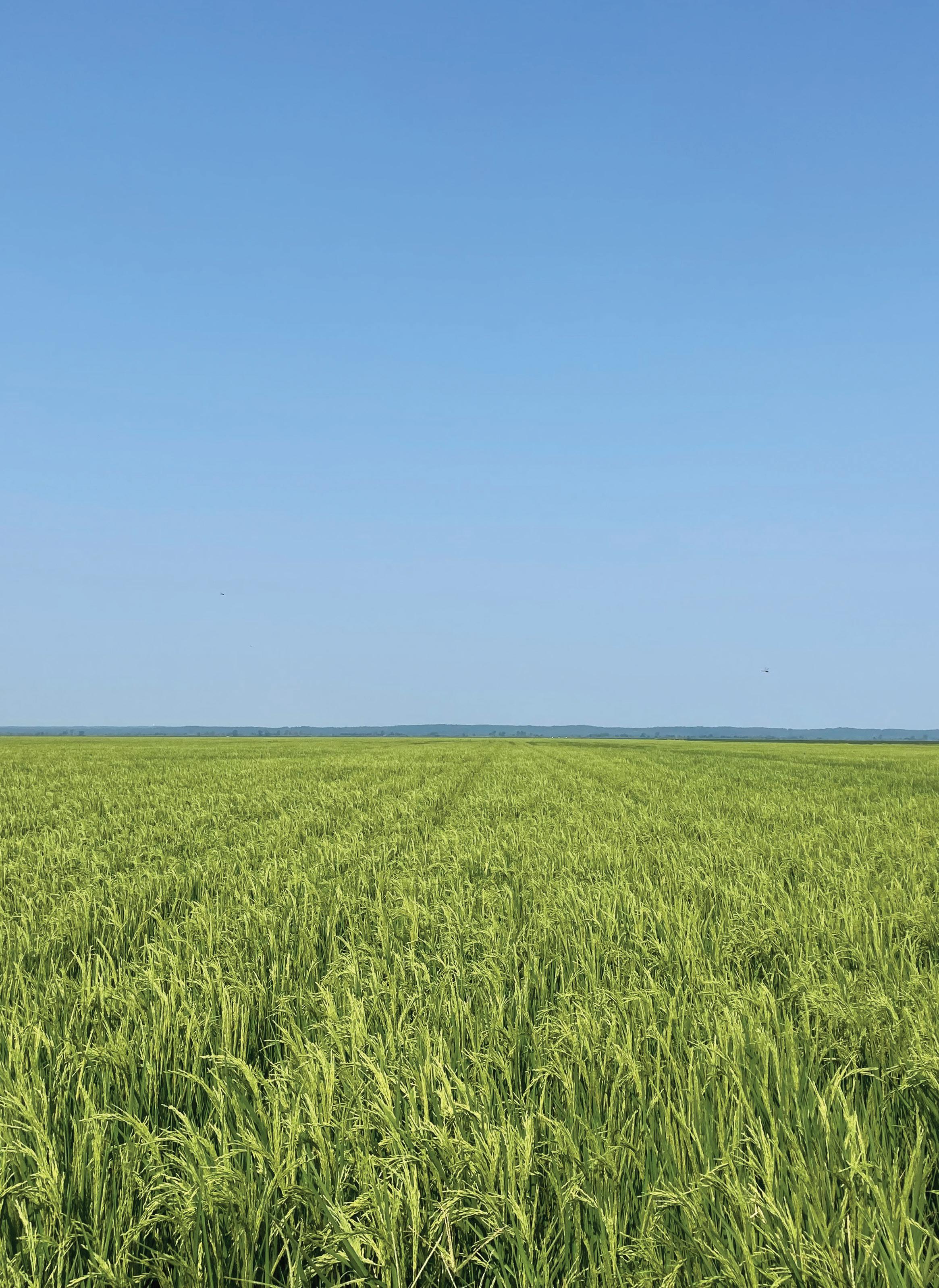
16 minute read
From the Editor
Learning as I go: My first exposure to rice in 2022
Before I began this job, someone told me that rice is a “whole different kind of cat” when it comes to crop production. I grew up in a land full of cotton, interlaced with some corn, milo, soybeans and wheat, and I don’t believe I fully comprehended what that might mean until this past year.
Rice is different. It takes a different kind of irrigation system, and timing is crucial. There are so many elements to the crop, but in my initial findings and proliferation of new terms and groups associated with it, I learned how closeknit the rice industry is. I had many describe it more along the lines of a big family, and I can’t Cassidy Nemec say I’ve found anything that contradicts that. Associate Editor
Across the board, it seemed like everyone I spoke with knew of nearly every person in the industry, both young and “experienced.” I’ve learned USA Rice plays a massive role for the present and future of rice throughout the U.S. and world. While keeping up with all the latest conservation and sustainability efforts and methods, USA Rice also has so many industry resources on their website. They are huge advocates for rice and want to prepare everyone else in the industry to be advocates as well.
The Rice Leadership Development program is one way they’re helping others gain insight into the country’s — and world’s — rice. There are numerous ways to get involved with this organization — if you already are, keep sharing with others!
This month’s Rice Farming discusses row rice as a consideration for those who have it as a viable option for their area. This was another lesson for me. Three specialists from three different states shared their wealth of knowledge in regard to the topic, and I found their perspectives to be fascinating.
I like to say a big aspect of growing is learning, and I can attest that I’ve grown through having such exposure to the rice industry these past several months. Whether it was a field day, a phone interview or a field visit, I took bits of information from each that I was unaware of beforehand. While I am so far from being an expert in these matters, or anywhere remotely close to those I’ve spoken to in terms of rice knowledge, I’m honored I can bring the vast intelligence of so many to readers and that I get the opportunity to continue to learn more every day.
Cassidy
EDITORIAL/PRODUCTION
Editor-In-Chief Carroll Smith csmith@onegrower.com
Associate Editor Cassidy Nemec cnemec@onegrower.com
Copy Editor Amanda Huber ahuber@onegrower.com
Digital Content Editor Katie Guthrie kguthrie@onegrower.com
Art Director Ashley Kumpe akumpe@onegrower.com
ADMINISTRATION
Publisher/Vice President Lia Guthrie 901-497-3689 lguthrie@onegrower.com
Associate Publisher/Editor-In-Chief Carroll Smith 901-326-4443 csmith@onegrower.com
Associate Publisher/Sales Manager Scott Emerson 386-462-1532 semerson@onegrower.com
Production Manager David Boyd dboyd@onegrower.com
Audience Services Kate Thomas 847-559-7514
For subscription changes or change of address, call 847-559-7578 or email ricefarming@omeda.com.
ONE GROWER
PUBLISHING, LLC
Mike Lamensdorf President/Treasurer Lia Guthrie Publisher/Vice President
ASSOCIATED PUBLICATIONS — One Grower Publishing LLC also publishes COTTON FARMING, THE PEANUT GROWER, SOYBEAN SOUTH and CORN SOUTH magazines. RICE FARMING (ISSN 0194-0929) is published monthly January through May, and Decem ber, by One Grower Publishing LLC, 875 W. Poplar Ave., Suite 23, Box 305, Collierville, TN 38017. POSTMASTER: Send address changes to OMEDA COMMUNICATIONS, CUSTOMER SERVICE DEPARTMENT, P.O. BOX 1388, NORTHBROOK, IL 60065-1388. Annual subscriptions are $25.00. International rates are $55.00 Canada/Mexico, $90.00 all other countries for Air-Speeded Delivery. (Surface delivery not available due to problems in reliability.) $5.00 single copy.
All statements, including product claims, are those of the person or organization making the statement or claim. The publisher does not adopt any such statement or claims as its own and any such statement or claim does not necessarily reflect the opinion of the publisher. RICE FARMING is a registered trademark of One Grower Publishing LLC, which reserves all rights granted by the U.S. Patent and Trademark Office in association with its registration.
© Copyright 2022
One Grower Publishing, LLC
Provisia Working Group Recommended BMPs for the Provisia Rice System
CROWLEY, Louisiana – With the Provisia® Rice System threatened by weedy rice outcrosses in some areas, industry leaders and farmers are coming together to implement strategies to steward and keep this important technology viable for years to come. Recently, ag retailers from the Coastal rice production region packed the Acadia Parish Extension Office auditorium in Crowley, Louisiana, to hear the Provisia Working Group’s recommendations for best management practices (BMPs) for limiting the development of weedy rice outcrosses to the ACCase-inhibiting herbicide technology. “The Provisia Rice System is the only thing we have right now for controlling weedy rice that has outcrossed with Clearfield® rice,” said Dr. Connor Webster, weed scientist at the LSU AgCenter. “If someone brought a new technology forward today, it would take several years before it could be commercially available. That’s why it is so important that we maintain this effective tool and prevent losing its effectiveness at the rate we are today.” The Provisia Working Group was organized earlier this year after weedy rice outcrossing was reported in at least 15 instances in Provisia rice in Louisiana. It’s made up of representatives from Horizon Ag, BASF, rice industry retail, and Louisiana university and extension leaders.

Best Management Practices
1. Use residual herbicides.
Command®, Prowl® and Facet® with grass activity control grass so that maximum coverage can occur with Provisia herbicide onto the weedy rice. Using residual herbicides for broadleaf activity PRE or DPRE (Sharpen®, Prowl, Facet, or Gambit® herbicides) will also reduce the need to tank-mix with the Provisia herbicide.
2. Be cautious of tank mixing herbicides that might lead to antagonism with your Provisia application.
Dr. Connor Webster, weed scientist at the LSU AgCenter, recommends having at least one application of Provisia alone, or two applications alone in a three-pass system. The size and population of weedy rice should always dictate follow-up applications.
3. Know which herbicides to mix – and which not to mix.
ALS-inhibiting herbicides can antagonize Provisia, although a second Provisia application 28 days after initial treatment can overcome much of the antagonism. Grasp® and Regiment® herbicides should be avoided for a tank mix, while sulfonylurea herbicides are better choices. For contact herbicides, Stam® herbicide severely antagonized Provisia activity, so propanil mixtures should be avoided. Basagran® and Sharpen herbicides antagonized Provisia activity at 14 days after treatment but were not antagonistic at 28 days.
4. Be diligent and clean fields up late-season.
If weedy rice is present, it needs to be taken out. This may mean using late-season herbicide applications, roguing, or spot spraying.
5. Consider crop rotation for success with Provisia rice.
Do not plant in the year following Clearfield® rice or where an imidazolinone herbicide was used the previous year due to the risk of carryover damage from the herbicide.
6. Be aggressive in fallow ground and soybeans.
Use tillage and Roundup® herbicide with residuals to increase the time between applications.
BASF Provisia Herbicide Recommendations
• Use only Provisia herbicide in Provisia rice. • Start clean, with burndown and/or tillage. • Let the size and population of weedy rice dictate follow-up applications. • Use residuals like grass and broadleaf herbicides for broad-spectrum control. • Do not mix Provisia with herbicides that have the potential to be antagonistic. • Apply to actively growing grasses, red rice and volunteer rice. • Make at least two (but no more than three) Provisia herbicide applications no later than panicle initiation. • Use proper carrier volumes of 10-15 GPA by ground and by air. • Only mix when weedy rice and grasses are small. • Clean equipment/combines. • Harvest fields with weedy rice last.
Stewardship In Crawfish Production
• Don’t allow Provisia rice to go to seed in crawfish production. • Don’t allow Provisia rice to go to seed in a non-rice year, including fallow or crawfish fields. • Control weedy rice and red rice at pond edges with glyphosate or other chemical or cultural methods. • Avoid using Provisia rice for green rice/crawfish forage production.
By Betsy Ward President and CEO USA Rice
2022, move along already
Another calendar year is coming to a close, and while it wasn’t the worst year in recent memory, I’m certainly fine to turn the calendar page.
From where I sit, just outside our nation’s capital, it felt like I was watching the Clint Eastwood movie, “The Good, The Bad, and The Ugly.”
The Ugly
The Ugly was, of course, the challenges facing the rice industry this year. I don’t have to tell you about the out-of-control input costs that pushed so many in agriculture, specifically rice, to an unprofitable year.
The Agricultural and Food Policy Center at Texas A&M University released an economic study in May that showed a $442 per acre loss in net cash farm income from 2021 to 2022 for rice farms, with as many as two-thirds expected to post a loss this year, which in the credit-heavy farm economy, is not sustainable.
We made this the central focus of our interactions with the government and media — even if, and especially if, they didn’t ask about it. I don’t think any government official we spoke with, at any level, on any topic, left that conversation without being well aware of the existential threat we see before the U.S. rice industry. The same was true with our media contacts, whether we were talking about unrest in Haiti or the latest TikTok recipe trends. And we didn’t stop there. Back in February, we made a clear and justifiable request for assistance for rice farmers to USDA, and we are working with our partners in Congress to continue to press for this much-needed support as we turn to the 2023 crop year.
Input costs were not the only factor affecting rice farmers in 2022. Unrelenting weather issues continue to challenge the industry. From the historic drought in California that sidelined 50% of their rice acres and threatens the long-term viability of so many communities, to the record-low water levels on the Mississippi River increasing transportation costs, and from flooding in parts of the Delta that interfered with harvest to a late frost in Louisiana that hurt ratoon crops. All factors beyond our control but certainly impactful in an already tough year.
The Bad
The Bad remains India. The world’s largest exporter of rice continues to thumb its nose at trade conventions. By their own admission, they over subsidize their rice industry and then dump rice on the world market, manipulating global prices and making it that much harder for U.S. rice farmers, who follow the rules, to make a living.
India’s bad behavior is another one of the topics we constantly highlight with government officials and the media. The U.S. government has complained about India to the World Trade Organization, and it’s telling that they’re not alone. The U.S. was joined by eight other member countries in voicing concerns. We continue to press the Biden Administration to do more and look to 2023 for real progress bringing India to account for their blatant disregard for rules.
The Good
But I did promise you some Good.
Rice was one of the most successful applicants in the Biden Administration’s new Climate Smart Commodity program. At least seven rice projects were funded at more than $150 million, with the USA Rice-Ducks Unlimited-National Black Growers Council proposal receiving the highest score from USDA and a commitment of $80 million for growers over five years.
We’ve also seen improvement in U.S. grain quality and varieties and have increased our direct dialogue with customers. From hosting reverse trade missions here to our series of Quality Symposiums that are a feature at the USA Rice Outlook Conference, we are seeing positive results from these efforts.
Thank you for continuing to grow food that feeds the world and for your commitment to making U.S.-grown rice a premium, climate-friendly product that we can proudly promote to all of our customers. Our job is to tell your story and improve conditions for you and your families.
David Gairhan (from left), Jim Whitaker, Jessica Whitaker, U.S. Secretary of Agriculture Tom Vilsack, Betsy Ward, PJ Haynie, Jeff Rutledge and Deborah Willenborg at the Climate Smart Announcement.



HARVEST YOUR RICE CROP WITH CHROME.
You’ve got tough harvesting conditions and abrasive rice crops. We’ve got the Axial-Flow® 250 series Chrome Edition combine. Load it up with industry leading technology like AFS Harvest Command™ combine automation and AFS AccuSync™, which allows you to share field data coverage maps, boundaries, and A/B guidance lines with multiple machines in the same field. Add AFS Connect™ to help you manage your farm, visualize agronomic data and more. And do it all with more durable, longer-lasting parts so you can stay productive through every harvest, season after season.
Contact your local Case IH dealer or visit caseih.com/chrome.
LEARN MORE FIND THE NEAREST CASE IH DEALER

Row rice revelations
Discovering furrow-irrigated rice as an industry player.
By Cassidy Nemec Associate Editor
Row rice has made strides over the past few years as growers have learned more about this different method of growing rice. Referred to interchangeably as furrow-irrigated rice, row rice is grown similarly to other row crops like soybeans or corn, as it uses poly-pipe irrigation rather than levee utilization. Specialists in some of the states that grow the majority of rice in the United States speak to some of the applications and discoveries of furrow-irrigated rice.
Benefits of furrow-irrigated rice production
Dr. Jarrod Hardke, a professor and Extension rice agronomist at the University of Arkansas, said row rice allows for the omission of building and tearing down levees and for the ability to apply more ground applications versus air. He suggested a benefit to row rice is cost.
“Levees are costly to construct and remove, require additional seed, and require that most fertilizer and chemicals be applied aerially.”
Dr. Hunter Bowman, an assistant professor and state rice specialist at Mississippi State University, said the ability to easily incorporate rice into a traditional row crop rotation with current equipment and labor is a major plus.
“Levee or paddy rice is typically grown in fields on land formed for rice production. These fields have slight to a zero-grade, allowing for minimal levees, which can often be straight levees. When planting rice on a field, not land formed with rice production in mind, often multiple contour levees are required. Flooding rice with contour levees can be labor intensive, and row rice helps reduce that labor cost. Row rice also allows a grower to rotate from soybeans to rice with less tractor trips across a field between the two crops,” Bowman said.
Dr. Ronnie Levy, a state rice specialist at LSU AgCenter, said row rice gives the grower an opportunity to switch crops based on the value of each crop. He said this is much more of a favorable economic venture in North Louisiana versus

South Louisiana where they grow crawfish and benefit more from levee-based systems.
Greenhouse gas emission reductions that come from alternate wetting and drying is a big advantage. There were benefits available through government programs that made row rice more economically viable to growers.
Cost of fertilizer was a big disadvantage for row rice this past year. Levy pointed out that, while soybeans can fix their own nitrogen, “we have to supply all the nitrogen for rice.”
The evolution of row rice operations
Though row rice would still need to be irrigated more frequently than other row crops, Hardke said growers are starting to get more comfortable with the idea of rice tolerating a flood but not requiring it. He suggested most first-time, row rice farmers tend to overwater the crop, but the 2022 drought saw the reverse with healthy-looking rice not receiving enough water.
“Soil type and slope both considerably change our options for row rice. On precision-leveled fields, we don’t have to construct beds, but instead, making water furrows is sufficient. However, on contour fields where side-slope is present, we still need to construct beds to keep water in the furrows. The best nitrogen strategies continue to be those that divide nitrogen up into multiple different applications (as opposed to largely relying on one big application in flooded rice),” Hardke concluded.
Bowman pointed out that row rice is not a new concept as it had been attempted in the ‘80s and ‘90s.
“The difference in then and now is that we have cultivars with better disease packages, we are more efficient with fertilizer, and we have done extensive work with irrigation timings in row rice,” he said.
After observing furrow-irrigated rice in Louisiana for a considerable amount of time, Levy said demand input costs have been a major factor in the evolution of furrow-irrigated rice in North Louisiana.
“It costs probably two to three times as much to plant an acre of rice versus an acre of soybeans,” so throwing in the added input costs doesn’t tend to help.
Row rice as a viable option for the future
Hardke spoke more to row rice’s application in Arkansas.
“Rotation between rice and other crops is simplified, and the economics improve due to reduced tillage passes. We can re-use old beds among rotational crops if the opportunity presents to see even greater efficiency,” he said.
While South Louisiana has different water-holding properties in soil, North Louisiana already has the rows that make row rice a viable option for growers.
Levy said row rice also enables the northern part of the state to introduce different herbicide programs to assist in their rotation. This can, in turn, solve problems in their other crops as well.
In Arkansas, Hardke sees row rice encompassing no more than 30% of the state’s acres anytime soon given current cultivars and practices. But he thinks the variables shown to growers over the past few years can still prove there are areas where row rice makes “a great deal of sense.”
“Row rice water use can be similar to, or even less than, flood rice systems. However, the timing of demand can be a notable issue. This is one of the standout factors making shifting to this practice more difficult. In areas where pumping stations are devoted to only a field or two, it is easy to move water back and forth. However, where pumping stations are tied into systems and not as easily swapped, things get complicated, and timings get missed.”
Hardke, after discussing the potential for yield penalties with incorrect irrigation timing, suggested row rice could still be viable where it is better-suited and the timing works out.
“I think we’ll continue to gradually increase as we learn more and improve, but for many acres flooded rice is still the more consistent practice,” he said.
Bowman sees a similar future for row rice in Mississippi.
“If we see an increase in row rice acres, it will be those growers who’ve traditionally grown other row crops and want to get into the rice market. I always say we have a strong group of rice growers in Mississippi who are good at what they do, and I don’t foresee them changing their operations. Acres will increase as we continue researching and gaining knowledge of row rice,” he concluded.
There may be a slight increase of row rice acres in North Louisiana, according to Levy, due to economic incentive programs. This may also come with a potential shift into South Louisiana if those incentives remain.
He said economic and environmental returns are what play most heavily into the decision-making process for furrow-irrigated rice.

DR. RONNIE LEVY Dr. Ronnie Levy, a state rice specialist at LSU AgCenter, said row rice gives the grower an opportunity to switch crops based on the value of each crop.




